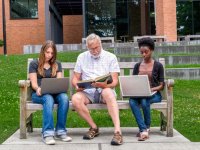Student Partnership in Professional Development
Through directed research and thoughtful session planning, students can play a significant role in their teachers’ professional development.
Professional development for educators has been experiencing a significant shift over the last several years. As educators become more connected and more networked, the idea of attending a conference as the sole source of learning is becoming outdated. Additionally, there's been a shift away from school districts being 100 percent responsible for educator growth and toward a more blended model that encourages educators to take ownership of their learning and growth.
A New Resource?
In the Union (Missouri) R-XI School District, we've tried to add an additional component to these shifts, which has proven to be successful so far: we've added our students to the professional development process.
One of our main goals as a district was to improve and enhance Tier 1 instruction. Far too often, we found ourselves working with our outlier students on both ends of the spectrum while skimming over the majority of students who fell right in the middle. Our reality was and is a reality that many districts face, as we didn't (and still don't) have the resources to add teams of instructional learning coaches.
So, lacking the resources to hire new personnel, we decided it was time to tap into the free resource we had sitting right in front of us. It was an energetic resource, available during school hours, that didn't have many high demands and was willing to work with both strict guidance and self-directed interests. This new resource was our students -- and what better way to take advantage of their availability and our need to provide additional professional growth opportunities for our educators?
Student Think Tanks
The first way that we've integrated our students into our professional development program was by initiating the Wildcat Instructional Technologist (WiT) program. This program is open to both junior and senior students at our high school, and serves our learning ecosystem in several different ways. Not only do our students receive one half of a semester elective credit just for being a part of the program, but they also serve as our own internal research and development department think tank.
This program is led by our one and only district instructional technology specialist, Josh Hall, and with Mr. Hall's guidance, these students receive their missions and their tasks. Though there is a lot of self-directed work that occurs in this program, the students get most of their marching orders by way of what our district needs in regard to enhancing and improving student learning.
For example, when looking to start our K-12 STEM program, several of our WiT students were tasked with researching different STEM kits and resources, and also contacting other schools with already-established STEM programs. From there, the students brought back their findings and presented to district administration the pros and cons associated with these resources. A thorough, student-assisted evaluation happened before many of our purchases. Then, once the decision was made, these students learned how to use the new equipment and helped roll it out to our teachers.
Probably the neatest part of this program is during these rollouts, when the students get to work side by side with our teachers to ensure overall understanding and effective implementation. It's amazing to see high school students working with and teaching their former teachers on some of the newest technologies and approaches to instructional technology in general.
Student Leadership
Another way that we've partnered with our students in professional development is through leading PD sessions for our staff. We have both middle and high school students plan, organize, lead, and facilitate staff learning sessions on our professional development days. Think about how powerful it is to turn the tables now that our students are sharing their thoughts with teachers about topics related to education and student learning. The conversations that have emerged as a result of these sessions have been rich and impactful. Perhaps most telling is that the results from staff surveys at the end our professional development days have been overwhelmingly positive. Some of the student-led sessions are the most popular activities on our PD days.
Though we are still looking to expand opportunities for our students to be co-partners in learning with our educators, we are very proud of the strides that we've made so far. Not only are our students gaining valuable experience working with adults in a much different capacity than usual in a typical school setting, they are also getting opportunities to research, explore, and discover new and exciting trends in education.
This partnership between educators and students in our district has strengthened the bond between adults and students and has helped create a culture of collaborative learning rather than the adults always being the ones with knowledge. The only regret we've had so far with this professional development partnership is that we didn't start it sooner.
How do you see students playing a role in teachers' professional development at your school?
